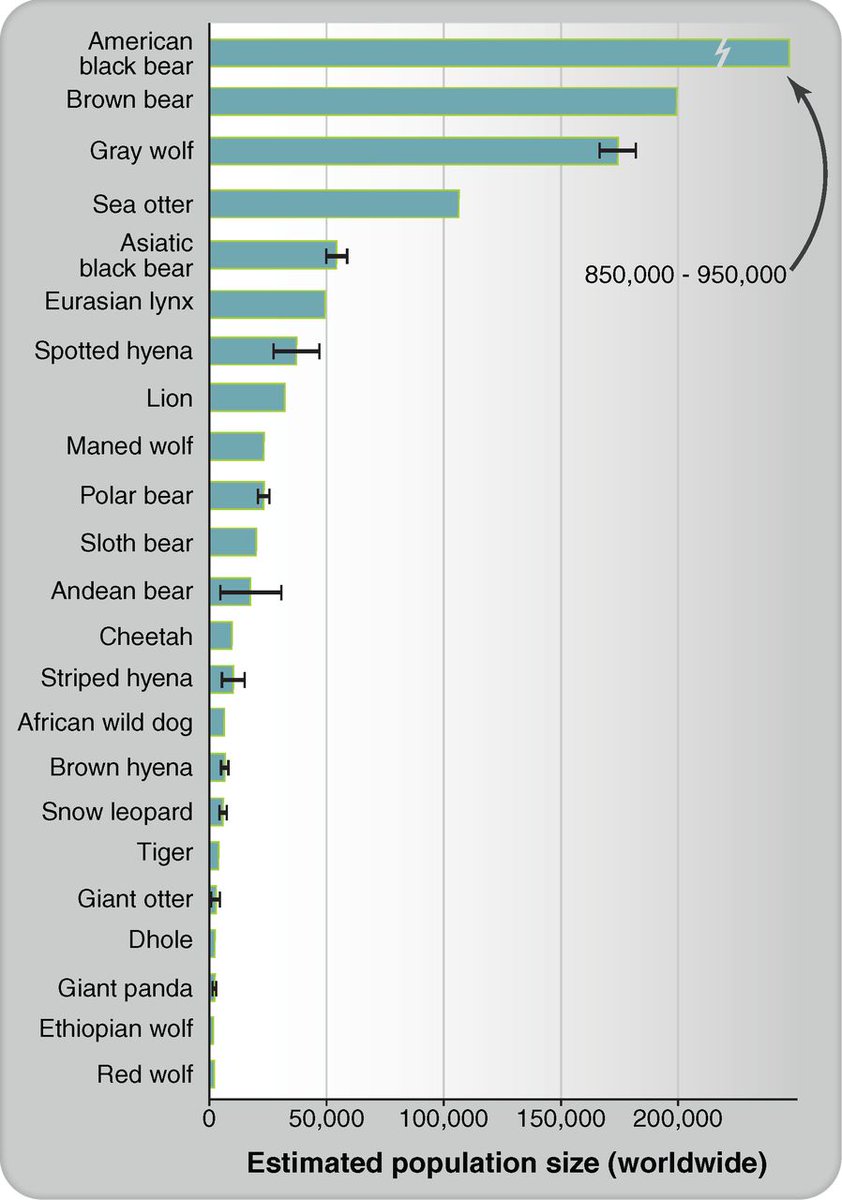Sadly, of the large carnivore species, more than 60% of them are threatened. Of the 17 showing widespread population declines, they now live in only 47% of their historical ranges. The tiger, for example, could have lost 95% of its historical range science.sciencemag.org/content/343/61… 

There are fewer than 3,900 tigers left in the world today due to widespread habitat loss, historic overhunting (thanks to us Brits), #humanwildlifeconflict and, more recently, #illegalwildlifetrade. Sadly, tigers are desired for their skins as rugs & their parts for medicine
Tigers continue to decline in many parts of south-east Asia but their population seems to be fairing better in India due to strictly enforced protected areas & efforts from the Global Tiger Forum 🐯hindustantimes.com/environment/ti…
In 2016, scientists heralded the first time in the last 100 years that tiger numbers increased. This was partly due to Indian efforts but also due to better methods to count tigers. But we mustn't keep our eye off the ball - more work is needed itv.com/news/2016-12-3…
There's sometimes the perception that conservation works best when you separate people from wildlife. This may be the case sometimes, but not always. The Solinga people of India live alongside tigers as they worship these big cats as gods bbc.co.uk/earth/story/20…
It's not just #illegalwildlifetrade that threatens tigers. In Bangladesh, the local mafia kill tigers as a gesture of goodwill towards the local community, similar to how Pablo Escobar handed out cash to locals bbc.com/earth/story/20…
Across the globe, people kill carnivores to protect themselves & their property. In the US, wolves are legally culled in some States & its thought that this reduces poaching. But @adrianxtreves & @CarnivoreSci found that wasn't the case bbc.co.uk/earth/story/20…
The above research suggested that if governments legalise the killing of a species (wolves in this case) it sends a signal to citizens that these animals are fair game, i.e. it normalises the killing of these species, which is why poaching goes up rspb.royalsocietypublishing.org/content/283/18…
Killing carnivores to protect livestock doesn't always solve the problem either. A study by Rob Wielgus & co. showed that the more wolves that are killed (up to a threshold of 25% of the population), the more the remainder preyed on livestock theconversation.com/wolf-cull-back…
Killing one of the leaders disrupts the pack and subordinate wolves, who often outnumber the breeders, are then free to reproduce. This could increase the number of breeding individuals in the area, thereby increasing the population of hungry wolves journals.plos.org/plosone/articl…
Whilst carnivore populations are declining in most places, there's been a resurgence of wolves, bears, lynx & wolverines in Europe. This is partly because good protection from policies like the Habitats Directive theconversation.com/if-you-go-down…
Hey I'm back from #NewcastlePride! For my final tweets I'll be talking about ways to conserve carnivore populations. First things first: habitat loss. As human populations & our developments expand, wildlife is squeezed into smaller & smaller spaces
E O Wilson proposed the "half earth" concept where humans concentrate their activities into half of the world, leaving the rest for wildlife. A novel & bold idea but sadly it has its problems theguardian.com/environment/20…
We've already seen in Europe that, with the right policies alongside the natural shift in human migration from rural to urban areas, carnivores can make a comeback newscientist.com/article/213270…
In developing countries, it would be unreasonable to stop them from utilising their natural resources but development must be done sustainably so as not to negatively impact wildlife. Unfortunately short-term economic gain usually wins over long-term environmental benefits
I'm sure you've all heard about the devastation #palmoil is causing to wildlife. However, it's all well & good us in developed countries telling developing countries not to cut down forests when in the UK we basically have no wild left. But development must be sustainable
#Palmoil threatens the last remaining Sumatran tigers & the crop is now being grown in jaguar habitat in S America too. We can't stop this from happening completely; what we can do is insist the crop only be grown on previously-converted land. Look out for @RSPOtweets labels 

We also need to pressure governments to keep national parks protected from development & find ways for financing these parks as they're expensive to run & the opportunity cost from not developing the land is high. Wildlife tourism alone sadly often doesn't sufficiently fund this
It's REALLY expensive to fund a protected area, especially if poaching is a problem, as fences & rangers are 💰💰Some countries allow consumptive use of wildlife to help fund conservation but this must be done sustainably or it drives population declines
Protected areas are definitely important to ensure carnivores survive for future generations to come, but they alone aren't the answer. We also must make sure people tolerate carnivores outside of protected areas, which can be hard if carnivores attack people, pets & livestock
About 1/4 of terrestrial land is pasture for livestock. In theory, this land could be shared with wildlife like carnivores. In Namibia, more wildlife is found in areas shared with livestock than in formally protected areas. This could be part of the solution
As carnivores do sometimes kill livestock, we must find ways for them to coexist otherwise livestock farmers risk wiping carnivores out in areas outside national parks theguardian.com/sustainable-bu…
Another serious threat we need to tackle is snaring. Snares are usually made of metal & designed to catch wild animals for meat. This poor lioness was photographed by @TheWCS @LionRecovery in Uganda. Snaring is hard to tackle as it's related to human poverty & hunger 

Great work is being done by @TheWCS @PantheraCats @LionRecovery & others to tackle the snaring problem, which involves patrolling protected areas. But we also have to address the root causes too (hunger, poverty & inequality), which is much harder to do news.mongabay.com/2012/06/new-ca…
Some carnivores, like the big cats, are threatened by #illegalwildlifetrade Again, anti-poaching squads help here but we have to tackle demand too else the problem shifts elsewhere. @TRAFFIC_WLTrade are doing some great work to limit this threat traffic.org/tigers/
My time's nearly up so before I go here's some things YOU can do to help protect carnivores:
✅Visit national parks; your entrance fees will help fund conservation
✅Donate to wildlife charities to support their work
✅Vote for political parties who care about the environment...
✅Visit national parks; your entrance fees will help fund conservation
✅Donate to wildlife charities to support their work
✅Vote for political parties who care about the environment...
✅Reduce your consumption; overconsumption threatens all wildlife
✅Buy sustainable products
✅Sign petitions to keep national parks protected
✅Don't buy illegal wildlife products
✅Don't share photos of you with wild carnivores as this fuels the pet trade of wild animals
✅Buy sustainable products
✅Sign petitions to keep national parks protected
✅Don't buy illegal wildlife products
✅Don't share photos of you with wild carnivores as this fuels the pet trade of wild animals
Right, that's it for me at @realscientists. Thanks everyone for a super fun week! If you've enjoyed my tweets, you can find me at @nikirust where I engage in #scicomm of how we can help save the planet. Remember, the power is within YOU! #GoPlaneteers 🌍 nikirust.com
• • •
Missing some Tweet in this thread? You can try to
force a refresh











